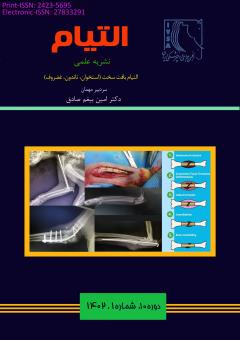مقاله کوتاه: روند ترمیم ضایعات استخوانی و شکستگی به همراه روشها و درمان مؤثر بر آن
محورهای موضوعی : علوم جراحی دامپزشکی شامل جراحی های بافت های سخت و نرمهانیه یابنده 1 , عبدالحمید میمندی پاریزی 2 , علیرضا شیخ زاده 3
1 - گروه علوم درمانگاهی، دانشکده دامپزشکی، دانشگاه شیراز، شیراز، ایران
2 - گروه علوم درمانگاهی دانشکده دامپزشکی دانشگاه شیراز، شیراز، ایران
3 - گروه علوم درمانگاهی، دانشکده دامپزشکی، دانشگاه شیراز، شیراز، ایران
کلید واژه: ترمیم شکستگی, کالوس, استئوبلاست, استئوکلاست, پیوند استخوانی, هیدروکسی آپاتایت,
چکیده مقاله :
ترمیم شکستگی شامل تکثیر و تمایز چندین نوع بافت در یک توالی و به دنبال آن بازسازی است. همه این فرایندها ممکن است تحتتأثیر داروها قرار گیرند. برخی داروها میتوانند روی تکثیر بافت کالوس اولیه، برخی دیگر بر تمایز سلولهای غضروفی یا استئوبلاست، تشکیل مویرگها، حساسیت به ورودی مکانیکی و غیره تأثیر بگذارد؛ بنابراین موضوع داروها و ترمیم شکستگی نهتنها شامل داروشناسی و ارتوپدی میشود، بلکه دامنه وسیعی را نیز شامل میشود. گامهای ترمیم استخوانی بعد از آسیب استخوانی شامل: گام اول مرحله تورم، گام دوم ترمیم استخوان اولیه (طی 4 تا 21 روز بعد، دور استخوان شکسته کال ایجاد میشود. این مرحله، مادهای به اسم کلاژن بهتدریج جای لخته خون را میگیرد)، گام سوم ترمیم استخوان ثانویه (تقریباً دو هفته بعد از شکستگی، سلولهایی به اسم استئوبلاست دستبهکار میشوند. این سلولها باعث جوشخوردن استخوان جدید میشوند و مواد معدنی موردنیاز برای استحکام استخوان را تأمین میکنند) و گام چهارم مرحله بازسازی (این مرحله سلولهایی به نام استئوکلاست تغییر و تعدیل موردنیاز را انجام میدهند. این سلولها هر استخوان اضافهای را که در این مرحله ترمیم شکلگرفته تجزیه میکنند تا شکل استخوان به حالت عادی برگردد). امروزه در ارتوپدی دامپزشکی و انسانی برای تحریک التیام شکستگیها، سرعتبخشیدن به اتصال مفصلی و ترمیم نقیصههای استخوانی از پیوند استخوانی خودی یا غیر خودی استفاده میشود. استخوان پیوندی خودی علاوه بر مواد تحریککننده التیام، حاوی سلولهایی است که واکنشهای ایمنی را تحریک نمیکند و باعث انتقال بیماریهای مسری نمیشود. در حال حاضر باتوجهبه مشکلاتی که پیوند خودی استخوانی دارد، تمایل برای استفاده از پیوند استخوانی غیرخودی مثل آلوگرافت و زنوگرافت بیشتر شده است. هیدروکسی آپاتایت سینتیک، تری کلسیم فسفات و ترکیب هر دوی آنها ازجمله مواد متداول برای پیوند استخوان هستند. هیدروکسی آپاتیت بهعنوان داربست جهت رشد سلولهای استخوانساز کار میکند تارانتولا کوبنسیس عصارهای است که به شکل وسیعی در درمان تومورها، آبلهها، سپتی سمی و بیماریهای توکسمیک مورداستفاده قرار میگیرد. همچنین از دیگر موادی که بهعنوان جایگزین استفاده میشود، پس از کاشت در محل ضایعات استخوانی، باعث القای تمایز سلولهای مزانشیمی متمایزنشده موجود در محل ضایعه به سلولهای غضروفی و یا سلولهای استخوانی نابالغ و سرانجام ترمیم موفقیتآمیز نقایص میشوند.
Fracture repair involves proliferation and differentiation of multiple tissue types in a sequence followed by regeneration. All of these processes may be affected by medications. Some drugs can affect the proliferation of primary callus tissue, others can affect the differentiation of chondrocytes or osteoblasts, formation of capillaries, sensitivity to mechanical input, etc. Therefore, the subject of drugs and fracture repair not only includes pharmacology and orthopedics, but also includes a wide scope. Repair steps after bone damage include: stage 1: (swelling stage), stage 2: (primary bone repair): over the next 4 to 21 days, a callus is formed around the broken bone. In this stage, a substance called collagen gradually replaces the blood clot. Step 3: (secondary bone repair) approximately two weeks after the fracture, cells called osteoblasts start working. These cells cause new bone to fuse and provide minerals needed for bone strength. Step 4: (reconstruction step): in this stage, cells called osteoclasts make the needed changes and adjustments. These cells break down any extra bone that is formed during this healing phase to return the bone shape to its normal status. In current veterinary and also human orthopedics, bone grafts are used for stimulation of fractures healing, accelerate joint fusion and repair of bone defects. Native grafted bone in addition to healing stimulator substances, contains cells that do not stimulate immune reactions and do not transmit infectious diseases. Currently, due to the problems of autologous bone grafting, the desire to use non-autologous bone grafts such as allograft and xenograft has increased. Kinetic hydroxyapatite, tricalcium phosphate and their both combination are among the common materials for bone grafting. Hydroxyapatite works as a scaffold for the growth of bone-forming cells; tarantula cubensis is an extract that is widely used in the treatment of tumors, smallpox, septicemia and toxemic diseases. Also, other materials that are used as substitutes, after being implanted at the site of bone lesions, induce the differentiation of undifferentiated mesenchymal cells present at the site of the lesion into chondrocytes or immature bone cells, and finally, the defects are successfully repaired.
1. Morgan EF, De Giacomo A, Gerstenfeld LC. Overview of Skeletal Repair (Fracture Healing and Its Assessment). Methods in Molecular Biology. 2014;:13-1.
2. Einhorn TA, Gerstenfeld LC. Fracture healing: mechanisms and interventions. Nature Reviews Rheumatology. 2014;11(1):45-4.
3. Ghiasi MS, Chen J, Vaziri A, Rodriguez EK, Nazarian A. Bone fracture healing in mechanobiological modeling: A review of principles and methods. Bone Reports. 2017;6:87-100.
4. Kostenuik P, Mirza FM. Fracture healing physiology and the quest for therapies for delayed healing and nonunion. Journal of Orthopaedic Research. 2016;35(2):213-2.
5. Marsell R, Einhorn TA. The biology of fracture healing. Injury. 2011;42(6):551-5.
6. FROST HM. The Biology of Fracture Healing. Clinical Orthopaedics and Related Research. 1989;2480.
7. Berendsen AD, Olsen BR. Bone development. Bone [Internet]. 2015 Nov;80:14–8.
8. Al-Rashid M, Khan W, Vemulapalli K. Principles of Fracture Fixation in Orthopaedic Trauma Surgery. Journal of Perioperative Practice. 2010 Mar;20(3):113–7.
9.Fragomen AT, Rozbruch SR. The Mechanics of External Fixation. HSS Journal [Internet]. 2006 Dec 21;3(1):13–29.
10. Karpouzos A, Diamantis E, Farmaki P, Savvanis S, Troupis T. Nutritional Aspects of Bone Health and Fracture Healing. Journal of Osteoporosis [Internet]. 2017;2017:1–10.


